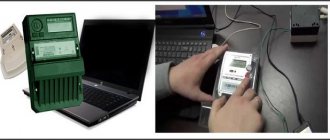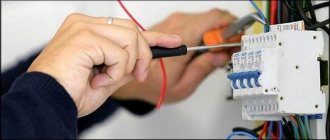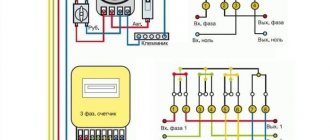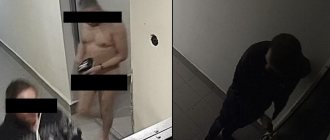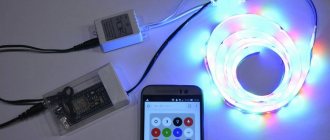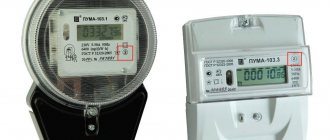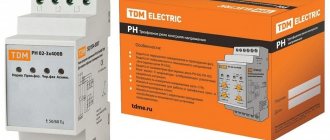Connecting a plot of land in a gardening non-profit partnership (SNT) to the electrical network significantly increases the comfort and convenience of working and relaxing on it. A garden house, provided with electricity, can be used for living not only in the summer, but also in other seasons.
There are certain rules for connecting SNT sections to electricity and payment procedures. One of the conditions for connection is the mandatory installation of electric meters, which determine electricity consumption; based on their indicators, payment is made for the supplied resource.
The electric meter can be of different models, but it must have an appropriate quality certificate. Installation of an electric meter at a dacha or in SNT is carried out by qualified craftsmen, payment for their work is made by the owners of garden plots.
Typically, meters are installed inside a private house, where they will be protected from moisture and from interference by strangers and from theft. But recently, representatives of energy companies are increasingly talking about moving the electricity meter outside buildings and even areas.
It is assumed that the devices will be placed on supports on the street, and to check the indicators, the energy sales inspector does not need to enter the site or obtain permission from its owner to enter the house. But the consumer cannot constantly monitor the condition of the device and protect it, especially since the owners of garden plots in the partnership do not permanently reside on their territory.
If the meter is placed on a pole, no one guarantees its safety and integrity. What are the current rules for installing an electricity meter in SNT? Does the energy company have the right to require the placement of electricity meters on poles? Is this legal? Information is important not only for members of gardening associations, but also for summer residents and owners of private houses in villages.
Why is it not profitable to install a meter on poles?
- Indoors, without exposure to cold or hot air, the device gives more accurate readings. The error of street meters, compared to home ones, can reach 10%. Considering the high cost of electricity for consumers, the amount to pay for electricity increases significantly.
- A meter that was installed on a pole will fail faster and will last a shorter time.
- Dust, humid air, wind, hail - all these natural factors cannot but affect the operation of the device. With this arrangement, electricity meters more often require repairs, and the accuracy of the indicators is often lost.
- When the meter is installed on the street, it needs to be monitored . After all, even from hooligan motives, someone can damage the device, and theft is not excluded, despite reliable fastening and connection to the electrical network.
- Energy companies force people to install electricity meters on the street, often counting on additional profits. After all, if the meter breaks down or completely fails, the consumer needs to pay for a new control device, a new installation, a new seal.
- Also interested in the fact that electricity meters in the sector of private houses, dachas, and garden plots are located on transmission line supports are also those companies that sell meters and check them.
There are many reasons for concern among owners of plots in holiday villages, gardening partnerships, and in the private sector. And therefore the question is whether the requirement to move the electric meter outside the house and even the yard is legal.
Arrangement of a cabinet for a meter
If an electronic electric meter was installed on a pole, then measures must be taken to protect it. Typically, such a device is mounted in special metal boxes equipped with a viewing window for taking readings of electricity consumption. It must be installed before installing the meter.
The metal box performs several functions:
protection against theft and vandalism. In order for the cabinet to cope with this task, it is necessary to install a reliable fastening and also provide it with a locking device;- ensuring protection of the metering device from moisture. Exposure to precipitation has an extremely negative impact on the service of the meter; it quickly fails;
- thermal protection. If the ambient temperature drops below 0°C, the electric meter will not work correctly. The error can be quite large, and often not in favor of the consumer. Therefore, it is better to ensure thermal insulation of the cabinet in which you plan to install an electronic meter in advance.
The wires from the meter must be hidden in a protective metal pipe. Only one circuit breaker is installed in the box itself, and it is better to install a distribution panel with circuit breakers for individual groups of consumers in the house.
Legislative norms
ATTENTION! Regarding the electricity meter, the law does not require it to be taken outside.
It is illegal for the power company to move the device to a utility pole. If a company representative insists on removal, the consumer has the right to refer to the following legislation and safety requirements:
- The Electrical Installation Rules (clause 1.5.27) indicate where the electricity meter should be located. It must be installed in a location suitable for maintenance. This place should have extremely low humidity, the temperature in winter should not be lower than 0 degrees. It is impossible to provide such conditions for operating the meter outdoors during the cold season.
- The PUE also gives the standard for placing the electric meter relative to the distance from the ground. The optimal location is at a height of 0.4 - 1.7 m.
- The same clause 1.5.27 of the Electrical Installation Rules says that the owner of the meter must monitor its safety, he is responsible for the device. But a gardener who is not always on the site cannot guarantee the safety of a device located outside the site.
Thus, mounting the device at a higher height on a pole violates the provisions of the main collection of standards for electrical installations. And taking readings from a meter installed higher than 1.7 m from the ground is not only inconvenient, but also dangerous. If the device hangs low outdoors, it will quickly be damaged.
It is understandable that electricity suppliers want to circumvent such requirements of regulations and legislation in order to gain additional profit. The rather high price for installing meters on poles will allow you to collect a certain amount.
In addition, it is easier for inspectors to take readings from devices if they are located on street poles. There is no need to go to each plot and wait for the gardener to appear on the territory of the partnership. With this arrangement, the indicators of electricity meters are always at hand.
Therefore, energy companies will insist on such an installation location. What should SNT members do in this case?
Organizational matters
First of all, it should be taken into account that the electric grid company makes a connection directly to the power grid only if all requirements for installing a metering panel and completing all necessary documents are met.
Therefore, the first stage is drawing up a project and approving it in the power grid organization. As a rule, an organization has standard designs for connecting to electrical networks and a list of requirements regarding the selection of the rating of protective devices, the type of electric meter, the cross-section of the input wire (cable), the type and design of the housing of the metering and distribution panel, as well as requirements for mounting the panel itself on a support or in the other place. It is possible that, at the request of the supplying organization, it will be necessary to connect the meter to an automated commercial electricity metering system (ASKUE).
Situations often arise when, after purchasing an input cable, installing a switchboard, metering device and the necessary protective devices without prior approval, the energy supply organization refuses to connect to the power grid and you have to correct installation errors or re-purchase a new electric meter, protective devices and other elements.
Therefore, if you already have a ready-made project, then before purchasing the necessary structural elements and proceeding with the installation of the electrical panel, you should agree on the project with the supplying organization.
Is it possible to refuse
ATTENTION! The energy company's requirement to move the meter outside violates the laws and regulations for the installation and operation of such devices.
Members of the partnership, faced with such intentions of the supplier, must write an official refusal to change the location of electricity meters. But perhaps such a solution will suit them better, in which case a meeting is held and a resolution is approved to move the devices to poles throughout the SNT.
ᐈ Installation of an Electricity Meter Kyiv - Price 2022 for Connecting an Electricity Meter
The All-Ukrainian TV channel in the program “Breakfast with 1+1” interviewed Roman Kirigetov, the founder of the Kabanchik.ua project, live about how the service works and how to safely order the services of private specialists in Ukraine.
For legal fixed electricity consumption, you need to install an electric meter - a service for installing and connecting a device that will keep records.
Correctly connecting an electric meter is a rather complicated procedure.
In this case, it is important to follow all connection rules, otherwise the meter will not be accepted for operation by a representative of the regulatory authority
So, it would be best to entrust this task to a professional electrician.
Rules for installing a meter, or why it is difficult
The general list of stages is significantly influenced by the type of metering device: depending on its mechanism, complexity and features, the sequence of work will be determined. In the standard version, the wizard performs the following actions:
Installation of the meter. Installation of the electric meter begins with fixing the device in the electrical panel housing using the screws included in the kit. At the same stage, automatic switches are installed on the DIN rail of the electrical panel to ensure safe operation of the electrical wiring.
Tire installation. At this stage, the specialist installs the protective grounding bus in the electrical panel housing on a DIN rail or support insulators
During the installation process, it is important to eliminate any risk of short circuits. Load connection
Phase conductors are connected to the lower terminals of the circuit breakers. The neutral conductor is connected to the corresponding bus, the ground wire is connected to the ground bus. The upper contacts of the circuit breakers are connected using jumpers.
Connecting the meter. To correctly install the electric meter, you need to use a conductor to connect the “phase” contact of the metering device with the upper contacts of the circuit breakers. The “zero” of the counter is connected to the zero bus. Having carried out these operations, the technician will secure the device in the electrical panel opposite the window for taking readings.
Trial. The installed meter is checked at idle, then gradually increasing the load. If everything is in order, you can call the controller to seal the meter. There will be no problems with its acceptance into operation.
How to quickly install an electric meter?
The installation speed of an electric meter depends on several points:
- type of electricity meter;
- site preparation (presence or absence of an electrical panel);
- master's experience;
- comfortable working conditions.
Price: Installation and replacement of an electric meter in Kyiv 2020
| Single-phase single-tariff | from 300 UAH |
| Single-phase multi-tariff | from 400 UAH |
| Three-phase direct connection | from 500 UAH. |
| Dismantling | from 150 UAH |
| Replacement or installation on a pole or support | from 800 UAH |
| Dismantling on a pole or support | from 600 UAH |
*Price current as of May 2020
Do you want to quickly install an electric meter in Kyiv with guarantees? Are you planning to spend the optimal amount and get high quality? It's real: just create a task on the Kabanchik website.
ua, and in a few minutes you will be able to choose an experienced, proven electrician with a good rating and positive feedback from customers. Using the service is a guarantee of an economical and safe service.
- Installation of overhead socket - from 50 UAH.
- Installation of surface-mounted switch - from 250 UAH.
- Switch relocation - from 200 UAH.
- Assembly of a chandelier - from 80 UAH.
- Installation of a doorbell - from 150 UAH.
- Installing a machine instead of a traffic jam - from 200 UAH.
- Installation of the meter - from 400 UAH.
- Installation of video surveillance - from 1500 UAH.
If you use the services of a master, the cost of the visit will be 0 UAH, but if the master advises you, but does not perform the work, the cost of the visit will be 150 UAH.
All our specialists undergo passport data verification. If you encounter an unscrupulous specialist, contact the support service for compensation of up to 1,000 UAH.
We work in all districts of Kyiv: Goloseevsky, Darnitsky, Desnyansky, Dneprovsky, Obolonsky, Pechersky, Podolsky, Svyatoshinsky, Solomensky, Shevchenkovsky.
Installation Rules
Typically, electricity meters are placed on poles or on the external wall of a house in the private sector, in a holiday village, or on the territory of gardening associations . With this arrangement, the inspector has constant access to the indicators, regardless of whether there is anyone in the house at the time of his arrival.
Despite the fact that it is recommended to install a meter of this type indoors with low humidity and a fairly warm temperature, it is also practiced to install it outdoors, on a wall or on a power line support. What are the rules for such an installation:
- There must be at least 25 meters from the installation site to the input module.
- If the meter hangs on a pole above the road, the distance from it to the ground should be at least 6 meters, if above the sidewalk - at least 3 meters.
- A special mount is provided for installation; external insulation is also used to protect the electric meter from external factors.
- The meter is installed in a special box (case) made of metal or plastic.
There are also additional requirements that ensure the safety of the installed device; only a qualified, experienced specialist can perform installation work in compliance with them.
IMPORTANT! The transfer of the meter is carried out only with permission from the energy company.
Types of meters
All installed electric meters can be classified according to several parameters. For example, the connection method, the type of measured quantities or the type of design.
Today, in residential buildings and apartments you can install one of the two most popular types of electricity meters:
- An induction meter measures energy consumption using a rotating aluminum disk. This type of meters is gradually being forced out of the market, as it has a number of disadvantages, one of which is low protection against electricity theft;
- Electronic meters allow you to control electricity consumption at differentiated tariffs. In addition, such devices can be controlled from a distance.
Which one will work better depends on many factors. Electronic meters have become most widespread. This became possible due to greater measurement accuracy and ease of use. In addition, you can take the device outside.
Which metering device is best to install depends on the characteristics of the use of electricity in the house, as well as its location - outdoors or indoors. Each of the existing types of meters has certain advantages and disadvantages.
When purchasing an electricity meter, you need to pay attention to the presence and integrity of the seal that is installed by the state trustee. The production time of the filling is of great importance. For a two-phase device it should not exceed two years, for a three-phase device - one year.
Who can connect
If at a general meeting (GM) the team made a positive decision to move meters, it is necessary that the work be carried out by qualified employees of the energy company.
Even if an outside electrician can perform the installation, certain authority is required to connect to the network and seal it. When the work is performed by a representative of the supplier, there will be no further claims against the consumer.
Meter transfer does not only involve technical processes. Representatives of the energy company must check the documents according to the boundary of division of balance sheet ownership, taking into account each device in the SNT.
Advantages and disadvantages
The main advantage is that there is no need to independently take and transmit readings
Through the use of devices of this class, it is possible to achieve certain advantages, manifested in the following:
- all disagreements and disputes between the energy supplier and consumer are resolved without much difficulty;
- data stored in the electronic memory of the system can always be presented to the user in documentary form with a printout of consumption by day of the week;
- the permissibility of using different payment tariffs;
- the ability to take readings from devices installed, for example, in a rented apartment.
When installing such devices, it is possible to install them in a home management system called a “smart home”. The use of remote control increases the safety of operation of accounting equipment, since it allows you to do without direct contact with it.
The disadvantages of automatic metering systems include high cost, as well as the need to protect (shield) communication lines from the effects of electromagnetic interference. In addition, when located on street poles, it is necessary to take special measures to protect against precipitation.
What to do after the transfer
Installation of the device at a new place of operation is carried out by a representative of energy sales. But the owner of the site needs to ensure that the device is put into operation correctly and that all necessary documents are completed:
- In order for the meter to be put into operation, you need to submit an application to the energy company. It indicates the consumer’s passport details, his contacts, and the number of the contract with the supplier.
- A company representative will fill out the documents and indicate the arrival time of the specialist to install the seal. The first sealing should be free.
- After putting the meter into operation, you need to make sure that it is reliably protected by a special shield with a transparent window for reading readings.
Do-it-yourself single-phase meter installation
To carry out installation yourself, it is recommended to proceed sequentially.
What will you need?
To work you need to prepare:
- Automatic machines. To shut down in case of an emergency.
- DF or RCD that breaks the circuit during a leak or short circuit.
- Boxing or special cabinet. The option is selected depending on the installation location.
- DIN rails for fixing equipment.
- Adapters, busbars and additional elements for connecting various parts.
- Voltage indicators and limiters.
- Standard set of tools.
- Single-phase electricity meter. The model is selected depending on the situation; devices from the Energomera brand are popular
Carrying out installation work
Installation of equipment and components:
- A box or cabinet is placed in a given place, and parts for hanging are fixed inside. The reliability and rigidity of the structure is checked. It is taken into account that height and accessibility must be respected.
- A two-pole circuit breaker is installed to quickly de-energize the home network. It is installed in front of the IPU, which is stated in the PEU.
- A new metering device is hung on the DIN rail, the evenness and reliability of placement is checked.
- If desired, an RCD is installed. You can skip this step and immediately install single-pole circuit breakers.
- The zero bus is fixed at the bottom of the box, and wires are prepared to create jumpers.
How to connect an electric meter
The equipment must be connected according to the following diagram:
- The supply wire is disconnected and sequentially inserted into the connectors of the two-pole circuit breaker (top). For convenience, you need to use color identification or mark the phase and zero.
- The meter is connected. The order of terminals on the device can be found in the passport.
- A jumper is stretched from the phase contact of the input circuit breaker to the IPU; the connection point on the mechanism is most often located at the very beginning.
- The neutral wire is fixed. It should go from the two-pole machine to the meter terminal (for most products No. 3), but not come into contact with the previous one.
- The phase with the IPU is allocated to single-pole circuit breakers or RCDs (can be located in the system before or after the machines, the second option is more preferable). The zero is fixed to the bus located below.
- (if available) and through the adapter part is immediately sent to the connected equipment, bypassing additional components.
Single-phase meter connection diagram
At this stage, the electricity meter is considered connected. To connect the house, a phase is supplied from the circuit breakers to the distribution box, and a zero from the zero bus.
Is it worth giving up?
According to legal regulations, electricity meters are placed outside only with the consent of the owner. The basis for submission to the SNT may be a collective decision made at a general meeting.
Initially, many may perceive such an innovation critically, fearing for the safety of their property. But you also need to take into account the benefits that a change in the location of the device will provide. The controller will no longer bother you with monthly visits.
The indicator data will be sent to the settlement center on time, this eliminates the accrual of penalties and fines, and the occurrence of any misunderstandings. The device is reliably protected by a special shield against hacking and theft. For SNT members, such placement of the meter can also have significant advantages.
Cable entry through a wooden house wall or foundation
If a self-supporting insulated wire or other conductor with aluminum conductors is laid from a pole to a wooden house, according to the PUE it cannot be introduced into the house: “laying cables with aluminum conductors over combustible structures is not allowed.” A switch to copper is needed. Most often, VVGng cable is used for this purpose - in non-flammable insulation.
It must be remembered that terminal boxes are used to connect these two conductors; ordinary twisting is unacceptable. Directly connected copper and aluminum enter into an active chemical reaction, quickly and strongly oxidize, which worsens the contact. As a result, even with minor loads, a spark appears at the connection point, and this is a direct path to a fire. Therefore, the use of terminal boxes is mandatory. They are available in a sealed case, and some are open. For outdoor use, of course, sealed ones are better; you can also install open ones in the house.
How to connect copper and aluminum wire
But that's not all. The power cable can only be routed through a wooden wall through a thick-walled steel pipe. The diameter of the pipe must be at least 4 times the outer diameter of the wire. The wall thickness is standardized (SP 31-110-2003) and must be no less than:
- 2.8 mm for a cable with a core cross-section of 4 sq. mm
- 3.2 mm for cables with conductors 6-10 sq. mm.
It is advisable to position the entrance with a reverse slope so that water does not flow inside. To seal entry and exit points, as well as to ensure electrical safety, you can use asbestos, rubber or plastic plugs. The edges of the pipe will need to be carefully processed and sanded until completely smooth so that the cable does not fray and its sheath is not damaged.
Entering an electrical cable through a wooden wall of a house
To calm down and increase reliability, the section that will be inside the pipe can be wrapped with asbestos thread or other insulating material. It can also fill the space inside the pipe to prevent insects from settling there. Another option is to fill the pipe with cement or alabaster mortar.
When entering through the foundation, the situation is slightly different: the structure is no longer considered combustible, so plastic embeds can be used. They are installed at the stage of manufacturing the strip foundation. In this case, the passage for the cable differs depending on whether the cable enters a wet or dry room.
Entering an electrical cable through the foundation of a house
The spare parts necessary for organizing the safe entry of electricians into the house do not cost very much, but significantly increase the reliability, electrical and fire safety of your home. The designs are quite simple; you can handle their construction with your own hands.
More details about the problem
Many summer residents are perplexed on what basis the chairman of SNT demands that electricity meters be moved from the house to the street. Most often, this requirement is due to the fact that it is easier to combat theft and it is easier to control resource consumption.
Out of the blue, the chairman of the SNT does not have the right to demand that the meters be moved to the street. According to the Federal Law dated April 15, 1998, number 66, as amended on July 3, 2016, all decisions of this kind must be made by the general meeting of owners.
In other words, before requiring the meter to be taken out into the street, a meeting must be held at which such a decision is made by a majority vote. If it was not there, then the requirement can be ignored. When the majority of neighbors decided that the meters should be taken outside, there was no choice, they would have to obey.
Connection diagram
The height at which the meter box should be installed should be in the range from 80 to 170 centimeters. According to the rules for installing an electricity meter in a private house, the device is located vertically, with a deviation not exceeding one degree.
There must be a switch in front of the meter that performs protective functions. Protective grounding must be provided. It can not only save you from a lightning strike, but also protect all electrical appliances in the house in case of a short circuit.
According to the diagram, the phase and neutral lines are input. Similar outputs are available. A panel with automatic switches is connected to them, which represents the wiring for a private house. The installed electric meter must have an inspection date with a period that has not yet expired.
When frost exceeds 5 degrees, the readings of the meter may be inaccurate. The error can reach 10%. To increase the accuracy of measurements, a heating device is installed inside the shield.
If the meter is installed during the construction of a private house or cottage, it will be useful to install sockets that will provide electricity to the devices used during the construction process.
What does the law say?
In accordance with the Decree of the Government of the Russian Federation dated June 4, 2012, number 442, paragraph 146, it is known that the installation, dismantling and current use of an individual metering device must be carried out on the basis of this document. But provided that the requirements of housing legislation and the Rules for the provision of public services for owners and users of residential premises of an apartment building and private properties do not differ.
According to paragraph 144, the electric meter must be installed on the border of the balance sheet.
The legislative draft also states that energy sales employees must have access to an individual metering device in order to take readings, assess the integrity of seals, and check mechanical effects.
And according to the Civil Code of the Russian Federation it turns out like this.
In what cases can you legally not stop at the request of the traffic police?
It follows from this that responsibility for the safety of the meter, the accuracy of the readings provided, etc., rests solely with the owner.

